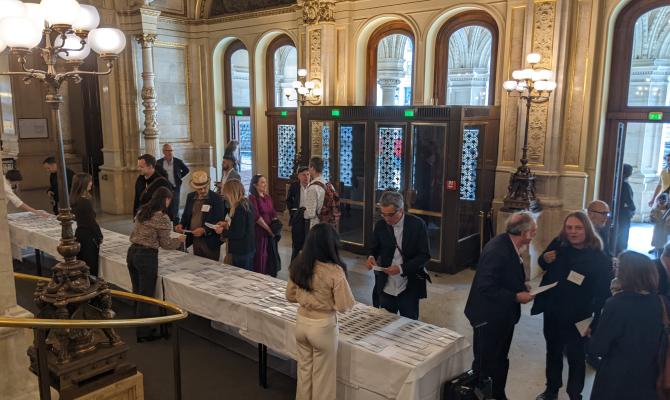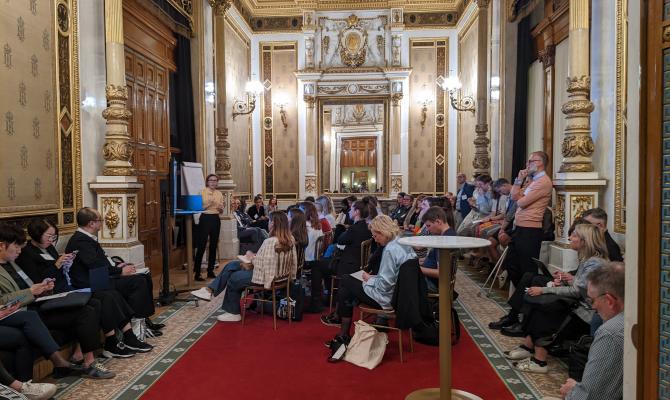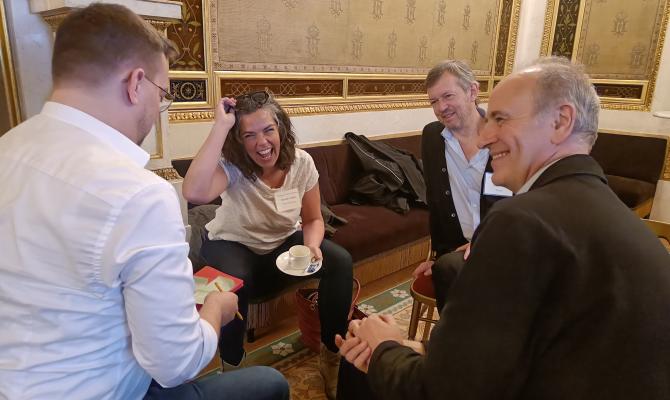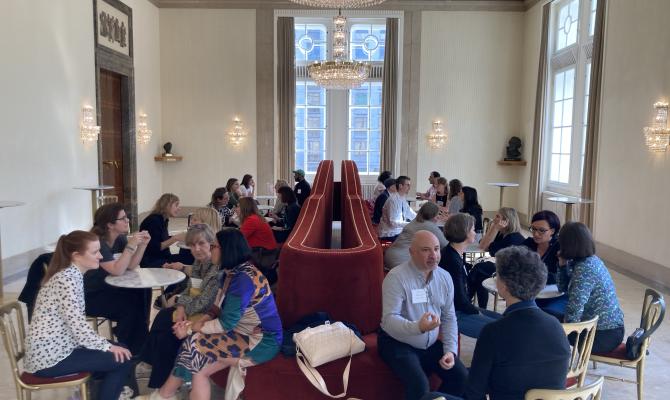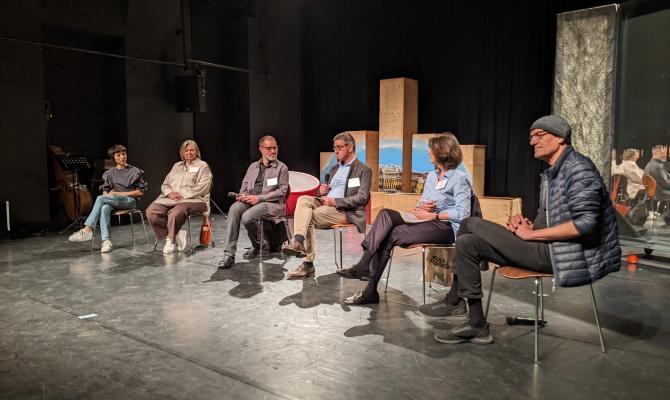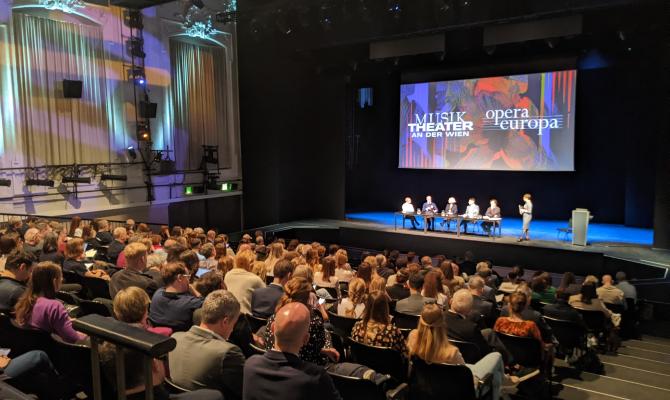Diamonds are made under pressure
David Karlin
16th April 2024
The conference brought together General and Artistic Directors with Heads of Marketing & Communications, Education and Fundraising, joining in discussions with artistic and audience focus. For the first time in over a decade, they were joined by Ballet Directors.
Any opera company has to work with a simple equation: grants plus donations plus audience income must exceed costs. Opera Europa’s spring conference tackled that “audience income” question from a variety of angles.
Vienna is home to three major opera companies, each of which hosted one day of the conference. Each Intendant – Bogdan Roščić at the Wiener Staatsoper, Stefan Herheim at MusikTheater an der Wien and Lotte de Beer at the Volksoper – introduced their houses and explained their different natures and the challenges they face. The Staatsoper is an institution replete with history, the guardian of a much beloved repertoire and traditions, a house which attracts tourists as much as it does locals – but which has to contend with many expectations that certain things must be maintained, some of those enshrined in legal agreements. MusikTheater an der Wien, a stagione house that also does chamber opera, is preparing for a return to its eponymous theatre in October, at the end of a lengthy spell of exile in Vienna’s Museumsquartier while the theatre has been in refurbishment. The Volksoper, another repertoire house, is considerably the youngest of the three, seeking new audiences and a distinctive artistic identity as befits its “People’s Opera” name.
With children’s opera specialist Wiener Taschenoper joining in as hosts, delegates had a bewildering variety of performances to choose from: Simon Boccanegra and Don Giovanni at the Staatsoper, Die Kameliendame by the Wiener Staatsballett, Die lustige Witwe, La rondine and Die lustigen Weiber von Windsor at the Volksoper, Kublai Khan at MusikTheater an der Wien – plus children’s operas, recitals and a trip to Bratislava for Slovak National Opera’s Svätopluk. This must surely have been one of the richest conferences ever in terms of performance opportunities (as well as coffee-and-cake offerings, this being Vienna, as evidenced by Saturday’s Guglhupf).
After the welcomes, the conference started with a stark reminder of why opera houses need to focus on their audience income, because it’s no longer possible to take government funding for granted. David Pountney’s keynote speech was a meticulously argued, blistering critique of the UK Government’s treatment of opera, starting with their part in the massive funding cuts announced in 2022 by Arts Council England and continuing with their more recent “misbegotten” report into UK opera. (A side note: I was interested to hear from Spanish houses that the “arm’s length” relationship, where the funding body acts as a buffer between arts institution and culture ministry, works effectively in Spain, a mechanism that has clearly failed in the UK). Pountney concluded with two crucial points: we must answer the questions “Whose stories are we telling?”, ”Who is telling them?” and “Who gets to decide which stories are told?” with new works “outside of and in addition to the traditional canon”, and “we need to look very carefully at the direction of flow of our income streams and be continually questioning whether our resources are being used in the wisest way”.
While the keynote struck a gloomy note as to the grant component of income, the conference mood was decidedly upbeat regarding the audience component. Most delegates I spoke to declared that the number of people attending performances had recovered to or exceeded pre-Covid levels; several also reported success in lowering their average audience age. A particular theme emerged that the pandemic had changed spending habits: clothing retailers are closing while restaurants and bars are opening, because people are hungry for sharing experiences with friends. Opera is a shareable experience par excellence, so how, one might ask, can the opera industry best take advantage? Of course, the flip side of the coin is that there is ever increasing competition for people’s free time (Elizabeth Morrison pointed out that The Royal Opera’s next door neighbours are currently Mamma Mia and Frozen).
For reasons of space, I’m not going to go through the conference session by session, nor was I able to attend most of the sessions related to artistic and educational matters (for example, I was sad to miss out on the interesting discussions about dance, and on any of the important research in Education). Rather, I’m going to zero in on some of the key themes discussed about audiences, whose threads ran through several sessions.
First, let’s look at inclusivity. Everyone wants to attract people new to opera into their houses: younger people, people from different ethnicities, people from social backgrounds who we perceive – rightly or wrongly – will think that opera is not for them. Ideas for achieving this were flying round the hall at a dizzying pace, so I’ll list just some. It could be a collaboration with another company that brings its own audience, like Dutch National Opera’s Operetta Land. It could be working with ethnic groups and merging musical forms (Opera North’s 2022 Orpheus, which merged Monteverdi with Indian music, wasn’t mentioned by name but is the most spectacular example that I’ve seen personally). Maybe it’s centering a production around street dance, like Teatro Real’s upcoming Les Indes Galantes. One can take opera out of its velvet-and-gold palaces and into the streets, like Parma’s “Verdi SPIP Parade”. There is huge potential for what was described as the “cross-pollination” between audiences in different art forms. Many will applaud the idea that opera evenings could be shorter: Magdeburg’s Julien Chavaz pointed out the possibility of doing Gianni Schicchi on its own, shorn of its triptych siblings or other interlopers. And why not offer subscribers a massive discount on a second ticket if they bring someone new to opera? Or make offers to the employees of corporate sponsors, which those sponsors can disseminate? Still, there’s a double-edged sword at play here. On the one hand, opera needs to break down barriers, as Kasper Holten highlighted in the Copenhagen conference: things just can’t be right when one of the most visited web pages on an opera company’s website is the one labelled “what should I wear to the opera”. On the other hand, many people love opera precisely because of its traditions, and visiting the opera has to be special – particularly if it’s in a historic house like Covent Garden or La Scala. The Palais Garnier in Paris welcomes over a million people per year to tour the building, because, Sophie Gavriloff explained, there is a resurgence of interest in people’s heritage: for at least some audiences to some forms of opera, whether new or established, the velvet-and-gold and the dressing up is part of the deal.
The second fascinating thread posited the idea of a continuum from visiting the opera house for the first time to seeing opera regularly to becoming a subscriber to becoming a sponsor. Houses trying to reduce their dependence on government funding need to maximise not only audience numbers but also revenue. A fully sold out house might not necessarily yield the available revenue due to various discounts and profile of seats. There were many useful discussions on how to manage subscription models to improve revenue.
The most important aspect of how to treat subscribers was universally agreed to be the need to make them feel valued and special, and many means of doing this were discussed. Only a few can emulate the Wiener Staatsoper, where the highest grade of subscribers get first refusal at tickets for the impossibly exclusive Opera Ball; more modest offerings involved access to “meet the artists” events, or simply having a dedicated box office phone line. But there’s a double-edged sword here also: every time you do a special offer to attract new audiences, you run the risk of perceived unfairness on the part of your loyal subscribers who aren’t being given the same deal. Yet another dichotomy lies in the question of complexity of subscription offerings: a rich variety of offerings means each person can find an offer targeted to them, but make the variety too rich and the whole thing becomes a nightmare to navigate for purchasers and implementers alike.
The work of outreach departments in building today and tomorrow’s audience was highlighted by a workshop animated by Hannah Griffiths. Various sessions discussed fundraising and sponsorship. A particularly interesting invitee was Alessandro Chiesi, a Parma businessman who engages in arts funding not merely for philanthropic reasons but because he sees it as a key means of making the city appeal to the best and brightest workers. Several speakers made clear how important it was to truly understand the motivation of a donor and tailor the offering accordingly: La Scala’s Lanfranco Li Cauli described a major donor who had failed to pass on her love of opera and ballet to her children and whose mission was therefore to create the love in other young people.
The opera industry always gives off a certain feeling of siege mentality, exemplified by David Pountney’s keynote. But if there was one sentence I heard that summed up this conference, it was the old saying that diamonds are made under pressure. Surely, there was enough energy and creativity in that room to hopefully carry us through. Or more prosaically, as Lyon’s Richard Brunel put it to me, “on trouve des moyens”.
Based in London, David is co-founder and director of Bachtrack, the international website for classical music, opera, ballet and dance.
https://bachtrack.com



